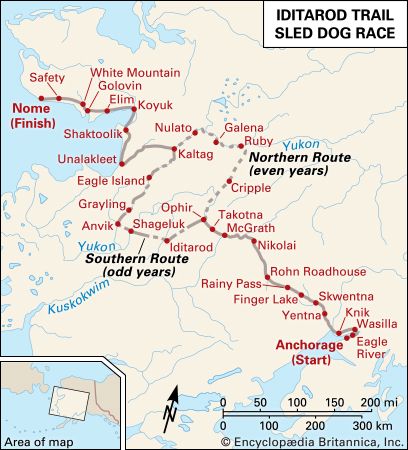 Every March the excitement of the Iditarod Trail Sled Dog Race grips Alaska. The race covers about 1,100 miles (1,770 kilometers) between the cities of Anchorage and Nome. Each sled is pulled by 12 to 16 dogs. The person driving the sled is called a musher.
Every March the excitement of the Iditarod Trail Sled Dog Race grips Alaska. The race covers about 1,100 miles (1,770 kilometers) between the cities of Anchorage and Nome. Each sled is pulled by 12 to 16 dogs. The person driving the sled is called a musher.
 The course length and route vary slightly from year to year. The race partially follows an old dogsled mail route. It crosses mountains and frozen rivers. Sled teams face cold temperatures and blowing snow. Champions have finished the race in less than 10 days. Most teams, however, take much more time than that.
The course length and route vary slightly from year to year. The race partially follows an old dogsled mail route. It crosses mountains and frozen rivers. Sled teams face cold temperatures and blowing snow. Champions have finished the race in less than 10 days. Most teams, however, take much more time than that.
Most mushers are from Alaska. The race also draws competitors from other states, Canada, and other countries. Men and women of all ages compete together. Susan Butcher and Rick Swenson are two of the most famous champions.
Sled dogs are chosen from breeds that do well in cold weather. Common choices include Inuit dogs, Siberian huskies, Samoyeds, and Alaskan Malamutes. Mushers train the dogs from puppyhood.
The Iditarod began in 1967 as a short race. It started as a way to celebrate the 100th anniversary of the U.S. purchase of Alaska. It developed into the current race in 1973.




